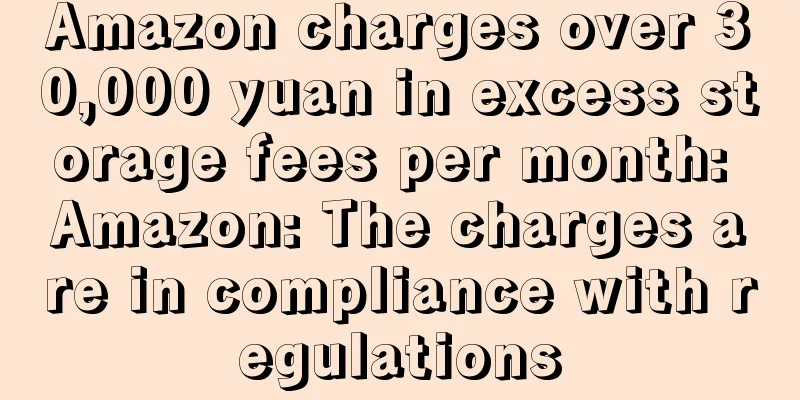|
It has been observed that recently, many sellers have reported on the forum that Amazon's storage fees have suddenly soared after July, far beyond the normal range . A seller said that he had applied for additional storage in June, but the excess storage fee estimated by Amazon in July also included the additional storage . He opened a case to inquire, and the customer service said it was a system error and asked the seller to pay the actual fee. He thought the bug would be fixed soon, but it was not until Amazon deducted a huge excess storage fee that the seller realized that the problem had not been solved at all. ▲ The picture comes from Zhiwubuyan
The seller's comments soon attracted more "victims". Another seller said: "I have already applied for additional storage space , but now I have to pay an excess storage fee of $5,000 a month ! I am still waiting for a response to the English case. I hope Amazon can be more reasonable." I applied for additional storage but was still charged excess storage fees. This sounds too outrageous. Is it really a system bug as the customer service said? Or did Amazon quietly change the charging standards? Miscalculation or "cutting leeks"? The situation was foreshadowed In fact, as early as the beginning of July, some sellers discovered that there was a bug in Amazon's backend inventory monitor . For any store whose IPI score did not meet the standard, if it applied for additional storage capacity, Amazon would display the estimated excess storage fee , even if the seller's storage volume was clearly within the limit.
In order to report the problem of incorrect storage fee display to Amazon, a seller kept opening cases to inquire about it within a month , but it was still not resolved. Unexpectedly, a problem really occurred in the end. ▲ The picture comes from Zhiwubuyan Not only in China, but also in the Amazon seller forum , sellers from all over the world are reporting the same situation. A seller from the United States said: "I was charged an overage fee, but my current usage is lower than my storage limit." The seller also attached a screenshot of the backend warehouse management page. ▲ The picture comes from the Amazon Seller Forum Another clothing seller also shared a screenshot of his backend. His storage limit increase period is from July 1 to September 30, and the standard size storage is 1043 . Clothing storage 3858. However, when Amazon calculated the excess fees, it used standard size storage 43 and clothing storage 1858. The additional storage capacity applied for was completely ineffective, causing the seller to be charged an additional $6,206 . ▲ The picture comes from the Amazon Seller Forum It is reported that the post on the seller forum was published on August 3 , and Amazon officially responded to the sellers' feedback on the same day, but the content of the response was not satisfactory... Amazon’s official response: Are the charges in compliance with the rules? Amazon charges overage fees once a month, but sellers are required to pay for each day in a given month that they exceed the limit, Amazon said .
For example, let's say your storage limit is 100, but because a shipment arrived earlier than expected, you exceeded that limit and reached 125 in three days. After three days, the excess inventory was sold out and the inventory returned to 100, but at the end of the month, you were still charged an overage fee for those three days. Even if the current inventory is below the storage limit, the estimated monthly storage fee is based on each instance of exceeding the limit during the billing period. ▲ The picture comes from the Amazon Seller Forum According to Amazon’s first reply, the sky-high overage fee was not a system error but a normal charge . This statement is probably difficult for all sellers to accept. More and more sellers began to use actual data to slap the official in the face. Soon, Amazon gave a second reply. ▲ The picture comes from the Amazon Seller Forum In the second reply, Amazon finally admitted that there was an error in the calculation of storage fees, and suggested that sellers consult " Amazon Seller Support " to assess the actual costs in order to obtain reimbursement . If there is no progress within 7 days , they can contact the official in the forum. In addition, Amazon also stated that the reason for the miscalculation of storage fees does not seem to be a technical problem , but it may be that the seller's storage limit has changed during this period. At present, the person in charge of FBA has been contacted to let them know about this situation. Recently, sellers have reported that they have received official emails, which show that the overcharged fees will be refunded within three weeks . If the seller has the above situation and has not received the email, he can explain the problem in the relevant post on the seller forum , attach his own backend screenshots and tag the Amazon administrator @Glenn_Amazon . The cross-border e-commerce environment is no longer what it used to be. Amazon sellers’ profits are already very slim, and being charged sky-high storage fees is like adding insult to injury. In this regard, I sincerely hope that sellers who have been charged extra storage fees can get a refund.
|










